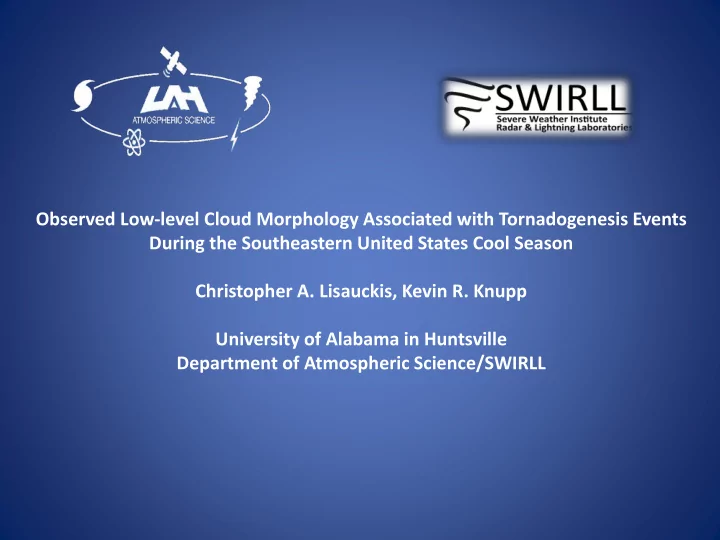

Observed Low-level Cloud Morphology Associated with Tornadogenesis Events During the Southeastern United States Cool Season Christopher A. Lisauckis, Kevin R. Knupp University of Alabama in Huntsville Department of Atmospheric Science/SWIRLL
I. Introduction • Cold season defined as the months of December, January, and February • Tornadogenesis in the southeastern United States often occurs under a broader range of conditions than other regions • High-Shear Low Cape (HSLC) events pose major operational forecasting challenges • Both Quasi-Linear Convective System (QLCS) and supercell convective modes have been observed under HSLC conditions
II. Background and Motivation • Parameterization of the convective boundary layer via Numerical Weather Prediction (NWP) (Cohen et al. 2015) -Cloud top mixed layers are especially challenging • Lifted Condensation Level (LCL) height and its role in HSLC environments (Rasmussen & Blanchard 1998) • Low level thermodynamic characteristics in southeastern U.S. tornado events (Jackson & Brown 2009) • Differences between LCL height and observed cloud base height (Craven et al. 2002) • Importance of boundary layer relative humidity in tornadogenesis (Markowski & Richardson 2008)
III. Methodology • Lidar ceilometer (University of Alabama in Huntsville (UAH) & NOAA ASOS datasets) - cloud base height, cloud fraction • Doppler wind lidar - boundary layer profiles of wind • 915 MHz wind profiler - turbulence (e.g., variance of vertical motion) • Microwave profiling radiometer - water vapor • Radiosondes • Current cases: Alabama, Mississippi, Louisiana, Georgia, and Tennessee.
IV. Results (Preliminary) • Cold season tornadoes in the southeast display a much broader range of temporal occurrence • Cloud base height tends to be <800 meters • QLCS cases had the highest observed cloud base height in the study • QLCS cases had highest storm relative helicity • Cloud cover tends to dominate southeast cold season tornado days hours in advance of tornado genesis
Cold Season Tornado Days Within 120 km of ARMOR Radar ( December 2004-February 2016) 6 5 5 5 4 3 3 2 1 0 December January February
Cold Season Storm Mode Distribution (Dec. 2004 – Feb. 2016) 0 5 10 15 20 25 30 QLCS 26 Supercell 12 Other 0
Bi-Hourly Cold Season Tornado Distribution (Dec. 2005 - Feb. 2015) 9 8 8 7 6 5 5 5 5 4 4 3 3 3 2 2 2 1 1 0 0 0 00/01 02/03 04/05 06/07 08/09 10/11 12/13 14/15 16/17 18/19 20/21 22/23
Cloud Base Height - All Cases (25) 900 800 763 700 695 670 600 620 623 629 568 545 500 meters 511 474 466 400 413 300 200 100 0 All Cases (26) Supercell (12) QLCS (14) QLCS Nulls (6) NOAA Ceilometer LCL (Lawrence) SPC Meso
Comparison of Cloud Base Height Among Three Sources Difference between observed cloud base and estimate is 100 m. Possible reasons: • Decoupling between surface and sub-cloud boundary layer • Negative gradient in mixing ratio
Ceilometer Observed Cloud Base Height Comparison 1000 900 877 800 819 700 600 meters 500 400 300 200 100 0 Shared Cases Within 45 km of UAH UAH (6) ASOS (6)
Ceilometer Observed Cloud Base Height 900 116.0% 800 772 700 100% 90.8% 665 600 604 104.3% 100% 73.8% 93.7% 500 meters 533 511 491 479 400 71.0% 363 300 200 100 0 All Cases (26) Supercell (12) QLCS (14) LCL (Lawrence) 6-12 UTC 18-00 UTC Daytime and Nocturnal Tornado and Storm Mode Distribution
Daytime/Nocturnal Ceilometer Observed Cloud Base Height by Storm Mode
Non-Severe QLCS (Null) Cases 700 600 629 545 500 474 400 meters 300 200 100 0 ASOS (6) LCL - Lawrence (6) SPC Meso (6)
Time Series of Ceilometer Observed Cloud Fraction Tornado Genesis • Cases consist of 5 QLCS’s and 1 supercell • Timescale is from 3 hours before tornado genesis to 45 minutes after
915 MHz and VAD Wind Profiler Derived Storm Relative Helicity Storm Relative Helicity 600 486 500 459 445 413 404 394 400 368 352 310 m2/s2 300 200 100 0 All Cases (20) Supercell (10) QLCS (10) 0-1 km 0-2 km 0-3 km
February 28, 2011 QLCS Tornado Genesis Case Onset of rain results in rapid decline in fields… Rain Onset Rain Onset Ceilometer observed cloud base height MPR observed liquid water content
V. Conclusions • Stratification of the low cloud deck often results due to strong advection • Low clouds prevail for at least three hours prior to southeast cold tornadoes indicating common cloud-top mixed layers • Day/night difference of SRH • Importance of cloud climatology to NWP validation VI. Future Work • Continue adding additional ceilometer cases to improve statistics • Study mixed layer characteristics via radiosondes • Compare radiosonde and ceilometer observations
Acknowledgements - I would like to thank: • My advisor: Dr. Kevin Knupp • Additional committee members: Dr. Larry Carey and Dr. Tim Coleman • Supporting contributions: Kyle Pennington, Corey Amiot, David Halizcer, Christina Leach *Funding for this research provided by: Subcontract 191001.363513.04A from the Northern Gulf Institute
References • Brown, M. E., and J. Jackson, 2009 Sounding-Derived Low-Level Thermodynamic Characteristics Associated With Tornadic And Nontornadic Supercell Environments In The Southeast United States. National Weather Digest, 33 , 15-26. • Cohen, A. E., S. M. Cavallo, M. C. Coniglio, and H. E. Brooks, 2015: A review of planetary boundary layer parameterization schemes and their sensitivity in simulating southeastern U.S. cold season severe weather environments. Wea. Forecasting , 30 , 591 – 612. • Craven, J. P. , R. E. Jewell, and H. E. Brooks, 2002: Comparison between Observed Convective Cloud-Base Heights and Lifting Condensation Level for Two Different Lifted Parcels. Wea. Forecasting, 17 , 885 – 890. • Markowski, P. M., and Y. P. Richardson, 2009: Tornadogenesis: Our current understanding, forecasting, considerations, and questions to guide future research. Atmospheric Research, 93, 3-10. • Rasmussen, E. N. and D. O. Blanchard, 1998: A Baseline Climatology Of Sounding-Derived Supercell And Tornado Forecast Parameters. Wea. Forecasting , 13 , 1148-1164.
Recommend
More recommend